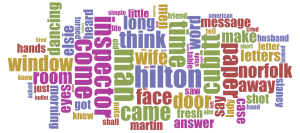For a change of pace, I read the Sherlock Holmes story, “The Adventure of the Dancing Men,” from Sir Arthur Conan Doyle’s The Return of Sherlock Holmes collection. I used the Voyant word cloud tool to visualize the story. The first version featured the words “holmes,” “mr,” and “mrs” that I deemed unimportant to the story. I realize now that, though “holmes” is a bit obvious and takes up a lot of room, the other words I listed indicate relationships which may be important to the overall story. Please bear this in mind as I continue without “mr” and “mrs” (because I took this screenshot on a different computer that allows screenshots and so I will be using this visualization):
The loss of “mr” and “mrs” may not be so terrible, after all. These “words” don’t modify any others to indicate which name they belong to, which I believe is a fault of the word cloud. If I were looking at this visualization and trying to find character names, they are spaced throughout and it is impossible to determine which first name goes with which last name, or if each name is even related. However, one can see that “husband” and “wife” are featured in the word cloud, so a marriage is implied. “Norfolk” also shows the setting of the story. While some related words point to a plot line — for example, “bullet,” “shot,” and “fired” suggest that a character has been or will be shot in the story — other related words like “man,” “men,” and “face” fail to create an image of just what the “Dancing Men” part of the title means. In reality, the dancing men are drawn stick figures used as a code to send messages to one of the characters.
The word cloud has the potential to give the viewer a lot of information about a document, but in some cases it may fall short of its purpose. The words used in this word cloud are no true representation of what occurs in the story. Looking at the picture, I can see that there is a husband and wife, a few named characters, a setting, a letter, and someone gets shot. This does not answer the question of who the dancing men are and, since the story is named after them, this is a lot of crucial information not being relayed.
Though I like the aesthetics and intention of the word cloud, I can understand why some people would be opposed to its existence, like Jacob Harris from the “Harmful” article we read seems to be. A narrative may be impossible to find in a cluster of frequently used words with no specific meaning; therefore, the word cloud may not be effective or properly convey the meaning of the document it represents.

Fascinating! I do not think I’v read through anything like this before.
http://telkomuniversity.ac.id